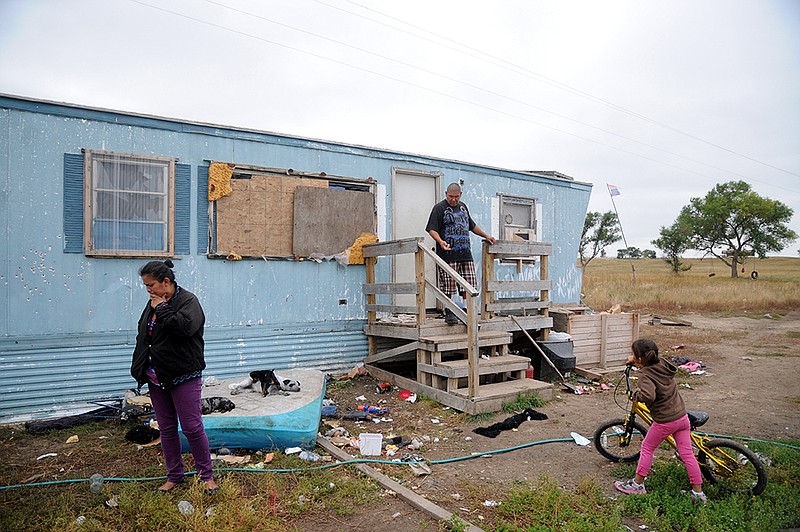PINE RIDGE, S.D.-Delora Kills Enemy sleeps on her van's back seat. Raymond Eagle Hawk, his girlfriend and young daughter live in a plywood-walled shack barely larger than their bed. Rachel Hunter shares a single bedroom with her boyfriend and two children.
The housing shortage on South Dakota's Pine Ridge Indian Reservation is a longstanding problem for thousands of Oglala Sioux members-from the poorest to those who can afford to buy a house-but the tribe is pushing the issue into the spotlight again after severe storms and flooding in May spurred a federal disaster declaration.
Roughly 200 households are receiving new homes and about 100 homes will be repaired. A task force of federal and tribal officials and housing advocates also began work this month on a new plan to address the shortage on the reservation of about 35,000 people, starting with a study of current houses and their condition to better understand the situation. Tribal officials say the reservation needs 4,000 more units to ease crowding and ensure residences have plumbing and electricity.
The task force will use the results in a plan to help address the shortage and improve the tribe's ability to get grant funding, federal officials said. Tribal housing leaders hope the numbers back up their estimates and spur federal recognition, since the largest direct grant for Native American housing programs hasn't kept up with inflation since the 1990s.
"I can show a plan from 1997 with the same amount of money and the same ideas," said Vince Martin, chief operating officer of Oglala Sioux Lakota Housing. "It's just not enough resources to meet that need."
The tribe gets between about $10 million to $12 million, which it uses to build an average of between 30 and 40 housing units a year.
Almost half of Pine Ridge's residents live in poverty, and unemployment sits at more than 21 percent, though some estimates peg joblessness as much higher among tribal members on the reservation.
Kills Enemy, 43, said she sells beadwork to buy gas to heat her van, where she makes a bed in the back while her husband sleeps in the front seat.
She's in a dispute over her father's house, and was forced to remove her tent from his land over the summer. Finding a home, Kills Enemy said, would be "everything."
Oglala Sioux Lakota Housing's inventory includes about 1,200 low-income rentals and roughly 500 homes for ownership that have been built since the 1960s, Martin said, estimating an average of between 12 and 15 people live in each home.
The housing authority's waiting list is hundreds of families long and can take years. It would likely include thousands if some people didn't let their applications lapse from discouragement, Martin said.
Raymond Eagle Hawk, 29, lives in a small shed next to his mother's trailer, near the site of the Wounded Knee massacre. His girlfriend, Natasha Cuny, said she's been on the list for about seven years. Neither work, but Eagle Hawk receives Social Security benefits.
The family shares an outhouse and gets water through a garden hose. The three boil water on an electric hot plate to stay warm in the shed, Cuny said. Conditions were no better when she was at her mother's house.
Cuny, 31, said she would like a home with running water and heat, but after years living largely with neither, she's not angry.
"Life goes on, and you can't do nothing about it," she said.
When they're lucky enough to reach the front of the line, tribal members are assigned a home, Martin said. For those who aren't working, federal aid is available to cover rent, which varies but can start at $100 a month for a two-bedroom unit. He said the tribe doesn't evict people who can't pay.
Meanwhile, those with the means to buy a home run into difficulties getting a loan and navigating the complexities of securing land on the reservation, but several organizations are there to help.
The nonprofit Oglala Sioux Tribe Partnership for Housing, which is participating in the task force, has put more than 100 people in homes since 1999, Executive Director Pinky Clifford said. The group works in concert with other organizations on financial literacy, homebuyer counseling, foreclosure prevention and credit repair.
Thunder Valley Community Development Corp., a nonprofit organization that has caught the eye of the Obama administration, broke ground in June on a sustainable community that's expected to include more than 20 homes, a grocery store and powwow grounds, among other features.
Executive Director Nick Tilsen said energy-efficient homes allow a family to put money that would have gone to high utility costs, a problem with older and dilapidated houses, toward a home loan.
Rachel Hunter, who works at a food company, has been approved for a mortgage in the community. The 25-year-old imagines Christmas in her new home, away from the confines of the single bedroom that her family shares.
"This is something I want. I want to be a homeowner," she said. "I want to set the example for my kids that there are things on the reservation. Hopefully whenever they're my age, there'll be more opportunity for homeownership."


